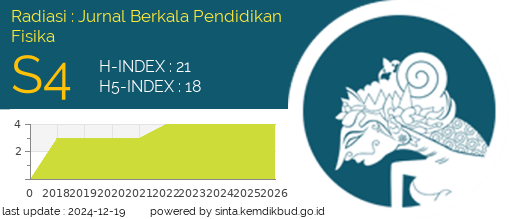Volta Drive Connect: Science Kit to Stimulate the Elementary Students in Sustainable Development
Abstract
The goal of this research is to develop the Volta Drive Connect science kit to increase energy literacy and inspire students to play a role in sustainable development. Volta Drive Connect consists of three levels with different components and levels of assembly difficulty. The research methodology uses developmental research with the ADDIE model (Analysis, Design, Development, Implementation, and eval__uation). The analysis phase involves the identification of learning needs and student characteristics. Instruments used are performance rubrics, observations, interviews, and documentation. The eval__uation of the effectiveness of the teaching kit was carried out using a paired samples test comparing student learning outcomes before and after using Volta Drive Connect. The test results show a significance value of 0.000 (p < 0.05), indicating a significant difference between the pre-test and post-test. Students' energy literacy increased significantly between before and after implementing Volta Drive Connect. Qualitative analysis of observation and interview data revealed increased learning motivation and student engagement during the use of the kit. Minor technical challenges identified during implementation were noted for improvement in future iterations of the kit. The development of Volta Drive Connect was successful in creating a learning medium that is effective in increasing energy literacy, and aligned with the goals of the SDGs.
Downloads
References
Kementerian Perencanaan Pembangunan Nasional/ Badan Perencanaan Pembangunan Nasional, “Peta Jalan Sustainable Development Goals (SDGs) di Indonesia,” Kementeri. PPN/Bappenas, p. 35, 2017, [Online]. Available: https://sdgs.bappenas.go.id/website/wp-content/uploads/2021/02/Roadmap_Bahasa-Indonesia_File-Upload.pdf
M. Balat, “Usage of Energy Sources and Environmental Problems,” Energy Explor. Exploit., vol. 23, no. 2, pp. 141–168, 2005, doi: 10.1260/0144598054530011.
R. Berahab, “The Energy Crisis of 2021 and its Implications for Africa,” Policy Cent. new South, pp. 1-1o, 2022.
S. Mujiyanto and G. Tiess, “Secure Energy Supply in 2025: Indonesia’s Need for an Energy Policy Strategy,” Energy Policy, vol. 61, no. 5, pp. 31–41, 2013, doi: 10.1016/j.enpol.2013.05.119.
Kristina, “Krisis Energi: Pengertian, Penyebab, dan Cara Mengatasinya,” Detik News. Accessed: Feb. 06, 2024. [Online]. Available: https://www.detik.com/edu/detikpedia/d-5756087/krisis-energi-pengertian-penyebab-dan-cara-mengatasinya
A. Al Bahij, Nadiroh, H. Rahmayani, and Sihadi, “Strategi Literasi Energi dalam Membentuk Perilaku Hemat Energi pada Anak Usia Sekolah Dasar,” J. Pendidik. Guru Sekol. Dasar, vol. 5, no. 1, pp. 7–13, 2019, [Online]. Available: http://journal.umpalangkaraya.ac.id/index._php/
N. Fadhilah et al., “Energy Experiment Teaching Kit sebagai Alat Bantu Materi Pembelajaran Energi Terbarukan yang Interaktif dalam Meningkatkan Keterampilan Sains Siswa SDN Ajung 01 Kalisat,” Sewagati, vol. 7, no. 4, pp. 634–642, 2023, doi: 10.12962/j26139960.v7i4.591.
H. N. Lukma, D. Yusofa, S. N. Wahid, and A. R. Ramadani, “Pengembangan Solar Cell Teaching Kit (SOCET) sebagai Alat Peraga Materi Konversi Energi,” Wiyata Dharma J. Penelit. dan eval_. Pendidik., vol. 11, no. 2, pp. 132–143, 2023, doi: 10.30738/wd.v11i2.16533.
L. A. Sanjaya, A. S. Budi, and I. M. Astra, “Pengembangan Alat Peraga Energi Terbarukan,” Pros. Semin. Nas. Fis., vol. V, pp. 45–48, 2016, doi: 10.21009/0305010210.
A. Maydiantoro, “Model Penelitian Pengembangan,” J. Pengemb. Profesi Pendidik, vol. (repositor, 2021.
S. A. Nurfatimah, S. Hasna, and D. Rostika, “Membangun Kualitas Pendidikan di Indonesia dalam Mewujudkan Program Sustainable Development Goals (SDGs),” J. Basicedu, vol. 6, no. 4, pp. 6145–6154, 2022, doi: 10.31004/basicedu.v6i4.3183.
I. Desti, “Literature Review : Upaya Energi Bersih dan Terjangkau,” J. Sains Edukatika Indones., vol. 4, no. 1, pp. 8–11, 2022.
S. S. Arifin and M. R. Syukri, “Implementasi SDGs Melalui Pelatihan Pengelolaan Sampah Anorganik,” Bul. SDGs UNG, vol. 1, no. 2, pp. 6–8, 2022.
F. Maulidna and A. Putra, “Peran Agen Perubahan dalam Implementasi SDGs untuk Aksi Perubahan Iklim: Tinjauan Kesadaran dan Tanggung Jawab Masyarakat,” J. Kependud. dan Pembang. Lingkung., vol. 3, no. 3, pp. 142–148, 2022.
J. E. DeWaters and S. E. Powers, “Energy Literacy of Secondary Students in New York State (USA): A Measure of Knowledge, Affect, and Behavior,” Energy Policy, vol. 39, no. 3, pp. 1699–1710, 2011, doi: 10.1016/j.enpol.2010.12.049.
Copyright (c) 2024 Khaerini Rahmania, Farah Nailis Saniyyah, Firnanda Millatin Afina, Desty Putri Hanifah

This work is licensed under a Creative Commons Attribution-NonCommercial 4.0 International License.




